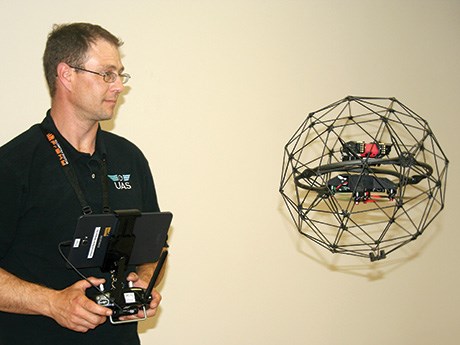Unmanned aerial vehicles ideal for accessing restricted areas in underground mines
Launching Unmanned Aerial Services Inc. (UAS) has been a dream come true for Matt MacKinnon. Growing up in Sudbury, MacKinnon was an avid radio remote control hobbyist. When unmanned aerial vehicles, or drones, went mainstream, he couldn’t resist the temptation.
“My wife bought me an AR drone and I loved it. It was great, but about three weeks into it, I ran into this WiFi issue and lost the link. It banked and just started flying away. I looked for it for two hours and couldn’t find it. I was heartbroken.”
Determined to understand what happened, MacKinnon immersed himself in research.
“It just took over my whole life. I dedicated every spare second to it.”
The idea of turning his hobby into a business took shape and, living in Sudbury, he was convinced that drones could play an important role in accessing and inspecting no-go areas in underground mines.
“I started doing a lot of testing underground and realized that off-the-shelf components just don’t work,” said MacKinnon. “They’re not designed for underground.”
Through a chance encounter with Jason Carriere of North American Palladium’s Lac des Iles Mine, he learned about the Elios drone, manufactured by Flyability SA, of Lausanne, Switzerland. Lac des Iles had hired Flyability to do some test flights with the Elios and MacKinnon reached out to them.
“If you lose radio link and video link and you can’t see what’s going on with a drone underground, what happens is because of the turbulence from the air, you have about three seconds to regain communication before your drone crashes into a wall,” he explained.
“The Elios is a caged drone that addresses the biggest concern underground. If you lose radio contact, it doesn’t crash and there’s a much better chance of recovery. It was a way to get into the market and introduce a technology that can access restricted areas underground.”
The Elios has an embedded high-definition 1080p camera, as well as an embedded thermal camera that can be used to perform thermal audits.
“With the thermal camera, you can actually see the form of a tunnel because of the difference in temperatures,” said MacKinnon.
One of his first jobs involved the inspection of an underground crusher station that was inaccessible because of a dam failure and flooding.
“They couldn’t go past a certain point and weren’t able to get eyes on it,” said MacKinnon.
Drones can also be used for conveyor belt inspections and to pinpoint the location of blockages in ore passes.
“You can check for hot rollers and bearings using a thermal camera and overlay the thermal image over the visual. In an ore pass, you can determine if it’s a dry plug or a wet plug.
“Doing one job that avoids having to set up scaffolding to perform an inspection can save a mine $100,000 to $150,000,” said MacKinnon.
UAS has negotiated an exclusive training representation agreement with Flyability for mining companies globally and operates as both a service provider and reseller.
Because it’s new technology, most mining companies will probably rely on UAS to provide the service instead of buying a drone themselves and going to the trouble of training a pilot in-house.
“But if they see the value of it and can see using it for multiple purposes, they can purchase a unit, in which case we’ll sell it, provide support and train a pilot,” said MacKinnon.
Range is a key concern.
“If we’re just going down a standard drift, we have really good range,” said MacKinnon. “If we have to access a parallel drift and fly through a crosscut to get to it, we start losing range, so we use a range extender, a remote controlled buggy that extends our controller by 68 feet.
“Normally, we tell our customers that we can handle a range of 500 feet, but I’ll ask them to send me the prints because we’re always willing to push the limits on it.”
UAS has partnered with a European company to refine a system specifically for underground with the ultimate objective of flying up to a kilometre around several corners.
“Drone technology is well understood on surface, but underground is a different story because of all the complexities, and a lot of it is having a robust radio signal,” he said.



